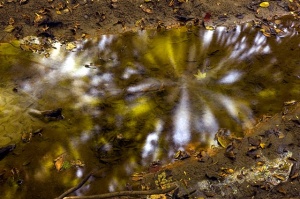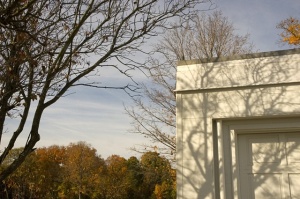 Alan Teller is a local photographer, teacher, business owner, and the latest artist to be featured in our ongoing exhibition series Local Art @ EPL. His show – titled Adlai’s Woods – is currently on display on the 2nd floor of EPL’s Main Branch and explores the landscape surrounding former Illinois Governor Adlai Stevenson’s Mettawa farm with a captivating collection of unexpectedly abstract photographs. You can catch Adlai’s Woods through July 8th, and after that, you can learn more about Mr. Teller’s photography and future projects by visiting his website. We recently spoke with Mr. Teller via email about Cartier-Bresson’s “decisive moment,” finding nature as a “city boy,” his new project in West Bengal, and supporting the arts in Evanston.
Alan Teller is a local photographer, teacher, business owner, and the latest artist to be featured in our ongoing exhibition series Local Art @ EPL. His show – titled Adlai’s Woods – is currently on display on the 2nd floor of EPL’s Main Branch and explores the landscape surrounding former Illinois Governor Adlai Stevenson’s Mettawa farm with a captivating collection of unexpectedly abstract photographs. You can catch Adlai’s Woods through July 8th, and after that, you can learn more about Mr. Teller’s photography and future projects by visiting his website. We recently spoke with Mr. Teller via email about Cartier-Bresson’s “decisive moment,” finding nature as a “city boy,” his new project in West Bengal, and supporting the arts in Evanston.
Evanston Public Library: Can you tell us a little about your background as an artist? How did you get started in art? Was there something specific in your life that sparked a need to create? What drove you to create in the beginning? What drives you now?
Alan Teller: My father was a photographer who taught at the High School of Art and Design in New York, so I grew up with all of this. One of my best remembered birthday presents was a stainless steel developing tank when I was 8. My dad was a commercial photographer, rather than an artist, but he taught me a love of the medium that hasn’t diminished over the past 50+ years that I’ve been making images.
Making art for me has always been a way of stopping the world and allowing me to control it in some manner. This was most evident when I used a view camera, where you look at an image upside down on a ground glass under a black cloth. A twist of a knob shifted the world in front of me, until it felt right, with everything in its proper place. Wouldn’t it be great if you could actually do that in the real world? It’s really the same thing with a smaller camera. Framing allows you to organize what you see in front of you so that it makes sense to you at the moment. When I photograph people or street scenes, it’s no different. I follow Cartier-Bresson’s idea that there is a “decisive moment” where all the elements of a picture–aesthetic, emotional, conceptual–come together. For me, making a photograph is also a way of permanently nudging a companion to say, “Hey! Did you see that?”
EPL: How do you describe your art? Do you see yourself as fitting in with any specific artistic movements or styles? Do you work in any other mediums in addition to photography?

AT: I’m probably more influenced by jazz than photography. I love the most contemporary, experimental and abstract jazz that is out there – music that makes you think, that plays with silences as much as with sound. While I appreciate the traditional landscapes of an Ansel Adams, I’m not interested in that kind of grandeur or in that sense of perfect beauty. For me, only rarely do those images become art. There are other more contemporary approaches to landscape photography that are quite stark, or that are concerned with a more overt political statement. I don’t fit in there either.
My only art is photography, although lately I’ve been working with my wife Jerri Zbiral (who is also a photographic artist) to craft pieces that combine both of our photographs with historical images and constructions. We’re hoping to show that work next year.
EPL: What was it about the landscape surrounding the Adlai Stevenson Center that first attracted your photographic eye? As a native New Yorker, do you often find inspiration for your art in nature?
AT: I’m constantly amazed that as a city-boy I find inspiration in the woods. I’d often be out there, knee-deep in muck, with mosquitoes swarming around me, and I’d say, “What am I doing here?” I think it is the solitude and the astonishing visual variety that surrounds you. It turns out, there is just so much to look at. Philosophically, I’m incredulous that we exist at all. When I was teaching photography many years ago, I would ask my students to pretend that they were visitors from Mars, dropped down on this planet to record the strange sights. That sense of seeing things as if you were seeing them for the first time still motivates me.
As for “Adlai’s Woods,” I knew that Governor Stevenson found solace in those woods, so I took a walk through the property soon after I was hired as Executive Director. My photography had always been scattered, consisting of images made all over the world – portraits, landscapes, street scenes, abstract studies. For some reason, it all came together on this small stretch of land by the Des Plaines River.
EPL: Could you discuss some of the choices you made in composing your “Adlai’s Woods” photographs? How did you decide to veer away from more traditional landscape photography in favor of more abstract images?

AT: It really wasn’t a conscious decision; things catch your eye or they don’t. And every image bears the experience of all those that preceded it. Some of the images in the series are fairly traditional, especially the ones that explore the land over time – say, the river in spring and the same spot in winter. Some are almost picture postcard-like in their composition. I couldn’t help it; it’s a photographer’s dilemma. But the ones that are most successful are the ones that go beyond the surface. “House Tree” is a perfect example, and one of my favorites. It’s an impossible photograph. Not everyone gets it – you have to look carefully to see the ways in which the shadows of the trees intersect with the real trees. A friend of mine who is an art teacher wants to use this picture in her class as an example of the importance of vantage point. Had I moved 2 inches in either direction, there would be no picture. That’s the stuff that fascinates me.
EPL: What are your future goals and plans as an artist? Do you have any plans to develop “Adlai’s Woods” further? Are you currently working on any other projects?
AT: I’m hoping to do a book on “Adlai’s Woods” that incorporates both my photographs and Adlai Stevenson’s writings about the environment. Along with his other forward-thinking beliefs, he was an early environmentalist. Not many people know that.
Yes, I am hard at work on a new project. Many years ago, at an estate sale, Jerri and I bought a box of anonymous photographs made in India in 1945. Last January, we went to India to see where they came from. I kept a blog about the experience that people might find of interest: http://vasa-project.com/blog/category/asia/. We are making new images based on our experiences, using the historic images as inspiration. We’re applying for funding and hope to return to West Bengal in 2013.
EPL: How do you find Evanston and the Chicagoland area as a place to work and exhibit as an artist? What inspires you as an artist about the community where you live?
AT: Evanston is a fantastic place to live. I’d have to be a multi-millionaire to live in New York the way I do here. We still, however, have few galleries in Evanston – they are all in Chicago. And our local Arts Council needs to be better funded if we hope to make a mark on the Midwest art scene. We have barely begun to create the individual, business and institutional partnerships that are needed to create an agency that can support Evanston artists in a serious way. I greatly appreciate the opportunity to show my work in the library, where it can be discovered by people who might not necessarily go to a gallery. We need more of these spaces!
Interview by Russell J.
